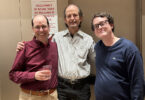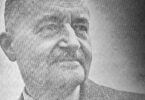Patriarch Tikhon, seeing that Archbishop Seraphim (Chichagov) would never be allowed to enter Poland, finally assigned Archbishop George as Metropolitan of Warsaw, according the Church in Poland the rights of a Metropolitan District. Soon thereafter, Patriarch Tikhon was arrested. In June 1922, at a Synod Meeting in Warsaw, Metropolitan George announced that due to the “turmoil and collapse of the Church in Russia, there may be objections to Polish autocephaly,” and that it would be sought from Constantinople and other autocephalous churches, as well as Patriarch Tikhon, “if he returned to Church Administration and if the Patriarchate in Russia was not abolished.” This minority decision among the Bishops was bolstered by an ecclesiastical court siding with Metropolitan George that dismissed both Bishop Elevferii (Bogoyavlenskii) of Vilno and Bishop Vladimir (Tikhonsitskii) of Bialystok. It was at this point in the controversy that the unthinkable happened. Archimandrite Smaragd (Latyshenko), rector of the Volhynia Theological Seminary, who was considered as one of the most “consistent, energetic, and knowledgable” opponents of autocephaly, on 23 Feb 1923, shot and killed Metropolitan George. It was revealed later that it had been his intention to also kill Bishop Dionisii, but, Dionisii had hidden in a closet, which saved his life. Archimandrite Smaragd was defrocked, and spent ten years in prison for his crime. It turned out that he had felt the assassinations would halt the autocephaly. This, of course, was not the case. Incredibly, Bishop Vladimir (Tikhonitskii) was charged with complicity, but it was soon seen he had nothing to do with the crime, and he acted as a witness at the trial. Later in 1923, he was elevated to Archbishop by Patriarch Tikhon; he spent a year under arrest at the Dermansky Monastery, and afterwards was deported from Poland to Czechoslovakia in 1924. He resided for a time with Bishop Sergey (Korolev) in Prague, before being appointed Bishop of Nice, France, by Metropolitan Evlogii (Georgievskii) in ROCOR’s Western European Diocese in 1925. [1]op. cit. 43
A pressing problem was the canonical election of a new Metropolitan, which had to be accomplished by three Bishops. This problem was solved by the consecration of Archimandrite Antony (Alexander Martsenko, 1887-1954, later Abp. of Tula and Belev) in Lublin by vicar bishops. The new Metropolitan, Dionisii, whose title was to be “Metropolitan of Warsaw and Volhynia, the Polish Orthodox Church, and Archimandrite of Pochaev Monastery,” had been elected by three Vicar Bishops-himself, Bishop Alexy (Gromadsky) of Lutsk, and Bishop Antony (Martsenko). Results of the election were not sent to the Patriarchate in Moscow; the Polish government communicated the results to Patriarch Meletios IV (Emmanuel Metaxakis, 1875-1931) in Constantinople, who gave his blessing to the new Metropolitan. In Apr 1924, the new calendar was adopted in the Church of Poland, also with the blessing of Patriarch Meletios IV. Patriarch Tikhon considered both the election and the interference of Patriarch Meletios IV as “uncanonical.” After the enthronement of Metropolitan Dionisii, Bishop Elevferii (Bogoyavlenskii) of Vilno was arrested and deported to Lithuania. At that point, all the Bishops remaining in Poland, in freedom, were those cooperating with the government. Bishop Panteleimon, who had Polish citizenship due to the fact that his father was Polish, could not be deported. He also had a brother in the Polish government, which was of no help. He was at first confined in the Meletskii Monastery, then, in the Dermanskii Monastery, and finally in the Zhirovitskii Monastery, without a Diocesan appointment, in forced retirement. His “retirement” lasted until 1939. [2]op. cit. 43,[3]http://drevo-info.ru/articles/16585.html,[4]op. cit. 39
Patriarch Meletios IV agreed that the Polish Church be given autocephaly. His successor, Patriarch Gregory VII of Constantinople signed a Tomos of Autocephaly in November, 1924. It was not awarded until Sep 1925 by Gregory”s successor, Patriarch Basil III. The Tomos gave autocephalous status to the new Orthodox Church of Poland, and included a rather ominous message for the Russian Church, which more than hinted at the Patriarchate of Constantinople”s intentions towards its persecuted and suffering Sister Church: “It is written in history that the forcible separation of the Kievan Metropolia with its subordinated dioceses in Poland and Lithuania from our See [of Constantinople], and its annexation to the Church of Moscow, occurred contrary to the codes of Canon Law. By this act, all rights which pertained to the full ecclesiastical autonomy of the Kievan Metropolitan, who had the title of Exarch of the Ecumenical Throne [the Patriarchate of Constantinople], were completely abrogated.” [5]Lincoln, W. Bruce Red Victory: A History of the Russian Civil War NY, 1989 pp. 156-157 While the abundant concern by the Patriarchate of Constantinople for the canonical correctness of an incident that had occurred nearly half a millennium before is touching, “canonical right” was not the only consideration in the granting of autocephaly to the Polish Church. “Researchers believe it is a proven fact that the autocephaly was “purchased.” ” The literature indicates that the Patriarchate of Constantinople was paid three million [Polish] zlotys; this is the amount noted as set aside in archival documents of the Polish Ministry of Foreign Affairs. Such was the price of the strong interest of the Polish government in the independence of the Polish Church from the Moscow Patriarchate.” In 1927, the Patriarchate of Constantinople granted the title of “His Beatitude” to Metropolitan Dionisii title granted to all heads of autocephalous Churches. [6]Keleher, Serge Orthodox Rivalry in the 20th Century: Moscow vs. Constantinople, in Church, State & Society, Vol. 25. No. 2, 1997,[7]http://www.rsijournal.net/tag/novejshee-vremya/page/7/
The grievances of the faithful were stated in short order by one of the eldest priests, Protopresbyter Terentii Teodorovich, at the Council of Bishops meeting in Warsaw in 1938: “Our hierarchy, all these past years [since the autocephaly], have tested us, “we, the Church.” “They” were convinced “we” can do all sorts of concessions in its traditional ecclesiology. Need to change the look of the priests, make them wear military uniforms? We agree-the “eastern” face [unshaven] of the priest-uncultured! Language of the services? Any language you want! The new calendar? Please! Autocephaly without rights, without the consent of the people of the Church, and the Mother Church? Ready! Forget your national language in sermons and in contact with the people, and even at home? Agreed! If only “they” keep their position, their privileges, their conveniences, and their power!”[8]ibid.
Vladika Panteleimon was confined in the Meletskii Monastery from 1922 to 1928. In 1925, at the request of Archimandrite Tikhon (Sharapov, 1866-1937, later Bishop of Alma-Ata, and New Martyr), Abbot of Zhirovitskii Monastery from 1922 to 1924, who also suffered persecution from authorities of both the Polish government and Church, Patriarch Tikhon elevated Vladika Panteleimon to Archbishop, in recognition of his faithfulness to the Russian Church and to canonical rectitude. In 1928, he was transferred to the Dermanskii Monastery, and, finally, in 1930 to the Zhirovitskii Monastery. He was forbidden to serve, but ignored the order. As well as he could in the circumstances, Archbishop Panteleimon was a leader in the movement against the introduction of the new calendar. When the Polish authorities and Church adopted the new calendar-a condition imposed by the Patriarchate of Constantinople, Vladika Panteleimon himself still adhered to the traditional Orthodox Church calendar. He did have some freedom of movement, and was active among the faithful. Vladika Panteleimon’s visits to the faithful in villages near to his places of confinement were always “great events.” Due to his warmth, accessibility, love, and simplicity, the “exile” Bishop conquered hearts wherever he went. When he preached in his “pleasant baritone voice,” he spoke loudly, as to be heard, and understood, which he felt did away with the perception of the time passing; while his homilies were sometimes lengthy, this was seldom noticed. [9]op. cit. 50
References
| ↵1 | op. cit. 43 |
|---|---|
| ↵2 | op. cit. 43, |
| ↵3 | http://drevo-info.ru/articles/16585.html, |
| ↵4 | op. cit. 39 |
| ↵5 | Lincoln, W. Bruce Red Victory: A History of the Russian Civil War NY, 1989 pp. 156-157 |
| ↵6 | Keleher, Serge Orthodox Rivalry in the 20th Century: Moscow vs. Constantinople, in Church, State & Society, Vol. 25. No. 2, 1997, |
| ↵7 | http://www.rsijournal.net/tag/novejshee-vremya/page/7/ |
| ↵8 | ibid. |
| ↵9 | op. cit. 50 |










